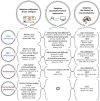A Neuroergonomics Approach to Mental Workload, Engagement and Human Performance
- PMID: 32317914
- PMCID: PMC7154497
- DOI: 10.3389/fnins.2020.00268
A Neuroergonomics Approach to Mental Workload, Engagement and Human Performance
Abstract
The assessment and prediction of cognitive performance is a key issue for any discipline concerned with human operators in the context of safety-critical behavior. Most of the research has focused on the measurement of mental workload but this construct remains difficult to operationalize despite decades of research on the topic. Recent advances in Neuroergonomics have expanded our understanding of neurocognitive processes across different operational domains. We provide a framework to disentangle those neural mechanisms that underpin the relationship between task demand, arousal, mental workload and human performance. This approach advocates targeting those specific mental states that precede a reduction of performance efficacy. A number of undesirable neurocognitive states (mind wandering, effort withdrawal, perseveration, inattentional phenomena) are identified and mapped within a two-dimensional conceptual space encompassing task engagement and arousal. We argue that monitoring the prefrontal cortex and its deactivation can index a generic shift from a nominal operational state to an impaired one where performance is likely to degrade. Neurophysiological, physiological and behavioral markers that specifically account for these states are identified. We then propose a typology of neuroadaptive countermeasures to mitigate these undesirable mental states.
Keywords: degraded attentional and executive mental states; mental workload; neuroergonomics; performance prediction; task engagement.
Copyright © 2020 Dehais, Lafont, Roy and Fairclough.
Figures




References
-
- Anund A., Fors C., Kecklund G., Leeuwen W. V., Åkerstedt T. (2015). Countermeasures for Fatigue in Transportation: A Review of Existing Methods for Drivers on Road, Rail, Sea And In Aviation. Linköping: Statens vägoch transportforskningsinstitut.
-
- Aricò P., Borghini G., Di Flumeri G., Colosimo A., Bonelli S., Golfetti A., et al. (2016). Adaptive automation triggered by EEG-based mental workload index: a passive brain-computer interface application in realistic air traffic control environment. Front. Hum. Neurosci. 10:539. 10.3389/fnhum.2016.00539 - DOI - PMC - PubMed
Publication types
LinkOut - more resources
Full Text Sources

